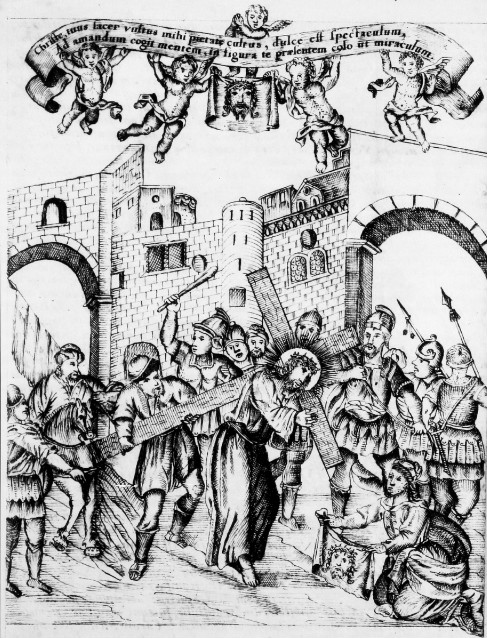Origins of the Via Dolorosa
Historical sources on the Via Dolorosa
The birth of the “Via Dolorosa” (XIII cent-)
(Anonymus, L’estat de la citez de Iherusalem, 8)
At the end of the street there is a gate leading to the Temple which is called the Sorrowful Gate (old french: Portes Doulereuses). From there Our Lord Jesus Christ went to Mount Carvary to be crucified. Foir thar reason is called Sorrowful. To the right of the Jehoshaphat Street there is a Monastery said of the Rest. And they say that in that place Our Lord Jesus Christ rested when he was lead to crucifixion. And there is the prison where he was put the night of his capture in Gethsemane; a little bit more forward on that street there was Pilate house.

(Fra Ricoldo da Monte Croce, Itinerario, year 1286)
And then coming (from the Probatica), we found the house of Herod and, nearby, the house of Pilate, where we saw the Lithostrotos, the place where the Lord was judged and the place where the people stood in front of the palace at the time that Pilate went out to them. Going up along the way by which Christ carrying the cross went up, we found the place where he said: “Daughters of Jerusalem, do not weep over me.” There they show the place where Our Lady stood stunned as he followed his son carrying the cross. And there beside the street there is a house as a place of remembrance. There they show the place where Christ with his cross stopped, tired, and rested a little. Beyond, in the transverse direction a road that is coming into the city, where they met Simon of Cyrene coming from the countryside and took the cross of Jesus. There is a place that was to the Friars Minor. Going up a path, not straight, for which ascended Christ, is a place where they say that Elena could demonstrate and discern the Lord’s cross from the robbers through the miracle of the resurrection of a dead. From there, we continued inside the church or place of the Holy Sepulchre.
The Saint Circle of the pilgrims (15th-16th cent.)
(William Wey, Itineraria, year 1458)
ASometimes it is not granted permission to enter into the church of the Holy Sepulchre, then the Friars Minor lead the pilgrims to other holy places. Going from the Holy Sepulchre to the east, now you will find a road for which Christ came up with his cross to be put to death; for the same path you come to the house of the rich man who denied the crumbs to Lazarus. Not far from there you get to the crossroads, where the Jews forced Simon of Cyrene to take the cross of Jesus; there is the place where Jesus said to the women, “Daughters of Jerusalem, do not weep over me.” There as well, on the right side, is the place where Jesus impressed his face upon the shroud and gave it to Veronica. So, not far from there is the place where the Blessed Virgin Mary fainted when she saw her son Jesus carrying his cross. In that place there was a church called by Christians Saint Mary of Spasmata, which is now destroyed. Further afield there is the site of the ancient gate of the city, through which Christ was led to death. And not far from there is the pool of Bethesda, where the angel once a day was moving the water. From there, over the vault of an arch, built askew on a square, from one to the other side, you see two white stones, over which Christ was standing when he was sentenced to death. There is the school of the Blessed Mary, where he learned the letters. And through that gate, by another way is the house of Pilate, in which Christ was scourged and condemned to death. Further on by the same square it is the home of King Herod, where Christ was mocked by Herod and clad in a white robe. Thus, further north, there is another square, where is the home of Simon the Pharisee where many sins of Mary Magdalene has been forgiven … (As a memory) of these holy places the following three verses follow:
Lap strat di trivium flent sudar sincopizavit
Por pis lap que scola domus Her Symonis Pharisei
Nati tem porta Ja sepul Sal aurea Stepha.



